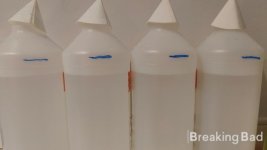WillD
Expert
- Joined
- Jul 19, 2021
- Messages
- 774
- Reaction score
- 1,060
- Points
- 93
For our experience, we need a battery electrolyte. I bought at once a can of 5 liters with a density of 1.28 g / cm3 (which corresponds to about 36% concentration). As probably everyone knows, the electrolyte is dilute sulfuric acid.
In order to obtain more concentrated acid, we need to try to evaporate all the water out of it. And knowing its initial concentration of 36%, it is clear that the electrolyte needs to fall about 3 times.
Next, we need a glass jar for evaporation of water from electrolyte. Then, you must apply marking on this jar using some measuring cup.


Since we need to evaporate the solution about three times, I put 3 marks in a step of 200 ml (cm3). Next, I poured 600 ml (cm3) of our electrolyte.
Prepared an electric stove. I put an unnecessary saucepan on the tile, in case the bank from heating will burst, so the bank is made from ordinary glass and is not intended for strong heating, unlike special chemical dishes.
Inside the pan piled a small layer of conventional sand so that the heating takes place as slowly and evenly.
Placed his jar with an electrolyte inside the pan and turned on the tile to the maximum.



The evaporation itself lasts long enough. I definitely did not count, but it is about 4-6 hours. And after our acid was evaporated to about 200 ml (cm3), turn off the tile and give our jar to cool. After that, you can pour our concentrated sulfuric acid into a suitable glass bottle.
To verify what kind of truly sulfuric acid concentration turned out in our experience, I took kitchen scales and weighed 100 ml (cm3) of our acid, measuring its volume with 60 cubic syringes. I got it that 100 ml (cm3) fluid weighs 167 g. This means that our acid density was 1.67 g/cm3, which corresponds to about 76% of the concentration, which is not quite bad.
To evaporate the acid of more concentration would be much more complicated because the concentrate acid, the harder it gives water.
In order to obtain more concentrated acid, we need to try to evaporate all the water out of it. And knowing its initial concentration of 36%, it is clear that the electrolyte needs to fall about 3 times.
Next, we need a glass jar for evaporation of water from electrolyte. Then, you must apply marking on this jar using some measuring cup.
Since we need to evaporate the solution about three times, I put 3 marks in a step of 200 ml (cm3). Next, I poured 600 ml (cm3) of our electrolyte.
Prepared an electric stove. I put an unnecessary saucepan on the tile, in case the bank from heating will burst, so the bank is made from ordinary glass and is not intended for strong heating, unlike special chemical dishes.
Inside the pan piled a small layer of conventional sand so that the heating takes place as slowly and evenly.
Placed his jar with an electrolyte inside the pan and turned on the tile to the maximum.
The evaporation itself lasts long enough. I definitely did not count, but it is about 4-6 hours. And after our acid was evaporated to about 200 ml (cm3), turn off the tile and give our jar to cool. After that, you can pour our concentrated sulfuric acid into a suitable glass bottle.
To verify what kind of truly sulfuric acid concentration turned out in our experience, I took kitchen scales and weighed 100 ml (cm3) of our acid, measuring its volume with 60 cubic syringes. I got it that 100 ml (cm3) fluid weighs 167 g. This means that our acid density was 1.67 g/cm3, which corresponds to about 76% of the concentration, which is not quite bad.
To evaporate the acid of more concentration would be much more complicated because the concentrate acid, the harder it gives water.
Last edited by a moderator:

